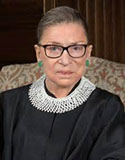
By: James G. Apple, Editor-in-Chief, International
Judicial Monitor
The United States Supreme Court is, as of the beginning of
the coming year, 229 years old. It took almost two hundred years for the U.S.
Government to appoint a female to the Court. Sandra Day O’Connor was the first
appointee (by President Ronald Reagan in 1981). The second woman appointee to
the Court, is Associate Justice Ruth Bader Ginsburg, selected in 1993 by
President Bill Clinton.
If there were ever a person who could be said the “live the
life of the law” it would be Justice Ginsburg. Since graduating from Columbia
Law School in 1959 (first in her class), she has been deeply involved in legal
matters, legal causes and legal organizations, often on a national scale.. Her
achievements and accomplishments in her years living with the law are many.
Justice Ginsburg was born in Brooklyn, New York in 1933. She
attended and graduated from high school there and enrolled at Cornell
University, from which she graduated in 1954 with a degree in government. She
married that same year a law student, Martin D. Ginsburg. She spent the
following year caring for her child while her husband served a two year term
as a reserve officer in the U.S. Army. Upon his return from active duty the
family moved to Cambridge, Massachusetts, both parents to attend Harvard Law
School. When her husband graduated from Harvard he took a legal position in New
York, she followed him and transferred to Columbia Law School, from which she
graduated. Upon graduation she secured a position as a law clerk for a U.S. district judge.
There is an anecdote about Justice Ginsburg when she was a
student at Harvard Law School. She was one of eight women enrolled in that Law
School. The dean of the school supposedly asked the women when there were
gathered at one time: “How do you justify taking a spot from a qualified man?”
The anecdote is indicative of the gender prejudice that existed not only in law
schools but in law practice during the 1950s and 1960s and before Even before her clerkship, and during her pre-Supreme Court
life, she had a number of significant accomplishments in her life in the law:
- Was first in her class at Columbia Law School
- Taught at Columbia Law School where she became the first female
tenured professor
- Co-authored the first legal textbook on sex discrimination
- Co-founded the Women’s Rights Law Reporter, the first law journal in the United States with a focus
exclusively on women’s rights
- Became Director of the Women’s Rights Project of the American
Civil Liberties Union (ACLU)
- Became General Counsel of the ACLU
- While at the ACLU argued six cases (as an advocate) before the
Supreme Court of the U.S., winning five of them.

 International
Judicial Monitor
International
Judicial Monitor